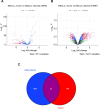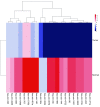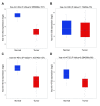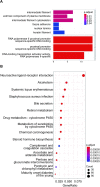Bioinformatics prediction of differential miRNAs in non-small cell lung cancer
- PMID: 34288959
- PMCID: PMC8294502
- DOI: 10.1371/journal.pone.0254854
Bioinformatics prediction of differential miRNAs in non-small cell lung cancer
Abstract
Background: Non-small cell lung cancer (NSCLC) accounts for 85% of all lung cancers. The drug resistance of NSCLC has clinically increased. This study aimed to screen miRNAs associated with NSCLC using bioinformatics analysis. We hope that the screened miRNA can provide a research direction for the subsequent treatment of NSCLC.
Methods: We screened out the common miRNAs after compared the NSCLC-related genes in the TCGA database and GEO database. Selected miRNA was performed ROC analysis, survival analysis, and enrichment analysis (GO term and KEGG pathway).
Results: A total of 21 miRNAs were screened in the two databases. And they were all highly expressed in normal and low in cancerous tissues. Hsa-mir-30a was selected by ROC analysis and survival analysis. Enrichment analysis showed that the function of hsa-mir-30a is mainly related to cell cycle regulation and drug metabolism.
Conclusion: Our study found that hsa-mir-30a was differentially expressed in NSCLC, and it mainly affected NSCLC by regulating the cell cycle and drug metabolism.
Conflict of interest statement
The authors have declared that no competing interests exist.
Figures






Similar articles
-
Identification of key microRNAs and hub genes in non-small-cell lung cancer using integrative bioinformatics and functional analyses.J Cell Biochem. 2020 Mar;121(3):2690-2703. doi: 10.1002/jcb.29489. Epub 2019 Nov 6. J Cell Biochem. 2020. PMID: 31692035
-
Plasma miRNAs in predicting radiosensitivity in non-small cell lung cancer.Tumour Biol. 2016 Sep;37(9):11927-11936. doi: 10.1007/s13277-016-5052-8. Epub 2016 Apr 13. Tumour Biol. 2016. PMID: 27075472 Free PMC article.
-
Microarray data analysis on gene and miRNA expression to identify biomarkers in non-small cell lung cancer.BMC Cancer. 2020 Apr 16;20(1):329. doi: 10.1186/s12885-020-06829-x. BMC Cancer. 2020. PMID: 32299382 Free PMC article.
-
Validation of miRNA prognostic power in hepatocellular carcinoma using expression data of independent datasets.Sci Rep. 2018 Jun 15;8(1):9227. doi: 10.1038/s41598-018-27521-y. Sci Rep. 2018. PMID: 29907753 Free PMC article. Review.
-
Identification of prognostic miRNA biomarkers for predicting overall survival of colon adenocarcinoma and bioinformatics analysis: A study based on The Cancer Genome Atlas database.J Cell Biochem. 2019 Jun;120(6):9839-9849. doi: 10.1002/jcb.28264. Epub 2018 Dec 9. J Cell Biochem. 2019. PMID: 30536901
Cited by
-
Knowledge, attitude, and practice toward lung cancer risk among offspring of lung cancer patients: a cross-sectional study.Sci Rep. 2024 Aug 3;14(1):18003. doi: 10.1038/s41598-024-69142-8. Sci Rep. 2024. PMID: 39097631 Free PMC article.
-
Identification of the Key miRNAs and Genes Associated with the Regulation of Non-Small Cell Lung Cancer: A Network-Based Approach.Genes (Basel). 2022 Jun 29;13(7):1174. doi: 10.3390/genes13071174. Genes (Basel). 2022. PMID: 35885958 Free PMC article.
-
Comprehensive Review: Unveiling the Pro-Oncogenic Roles of IL-1ß and PD-1/PD-L1 in NSCLC Development and Targeting Their Pathways for Clinical Management.Int J Mol Sci. 2023 Jul 17;24(14):11547. doi: 10.3390/ijms241411547. Int J Mol Sci. 2023. PMID: 37511306 Free PMC article.
References
-
- Herbst RS, Baas P, Kim DW, Felip E, Pérez-Gracia JL, Han JY, et al.. Pembrolizumab versus docetaxel for previously treated, PD-L1-positive, advanced non-small-cell lung cancer (KEYNOTE-010): a randomised controlled trial. Lancet. 2016;387(10027):1540–50. Epub 2015/12/30. doi: 10.1016/S0140-6736(15)01281-7 . - DOI - PubMed
Publication types
MeSH terms
Substances
LinkOut - more resources
Full Text Sources
Medical

